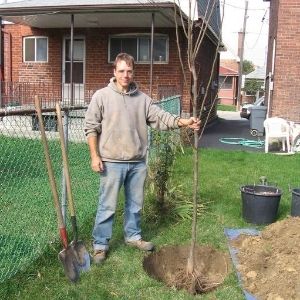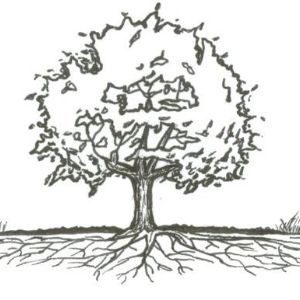Here are five common misconceptions about trees:

Tree roots choose the path of least resistance and tend to grow towards available oxygen and water. It would require too much effort for roots to grow through concrete so when they do come up against a foundation, they typically grow alongside it. If a foundation or pipe is already damaged however, roots can grow into existing cracks, as there is often available oxygen and water. To avoid indirect damage, plant trees at a reasonable distance from your house and water them regularly.
Myth #2: It is important to add new soil and chemical fertilizers when planting a tree.
Backfilling a planting hole with new soil or adding chemical fertilizers may seem like helpful gestures but they can actually be harmful to your tree. Once planted, tree roots grow outwards into the surrounding soil. When planted in a small pocket of rich soil, roots can grow in circles, rather than venturing out into the less favourable soil outside the planting hole. As a result, root growth can be restricted. Because each species of tree prefers different soil growing conditions, it is better to match a tree species to the existing soil type in your yard.
Furthermore, using high-nitrogen fertilizers can cause rapid tree growth. While the top of the tree grows quickly, the trunk cannot often keep up, causing a weight imbalance that leads to a “bent-over” tree. A more balanced way to provide nutrients to your tree is by adding a thin layer of organic, slow-release compost on top of the soil.
Myth #3: Newly planted trees should always be staked.
A newly planted tree should only be staked under certain conditions. For the first few years after planting, a tree focuses on growing and establishing a strong root system. This underground root growth is stimulated by the gentle movement of the tree in the breeze aboveground. When a tree is staked, this movement can become restricted and the signals for root growth are not always transmitted.
Staking a new tree may be necessary in very windy or high foot traffic areas. It may also be necessary if a tree is top-heavy when planted (when the canopy is larger than the root ball). When staking, only soft, flexible materials should be used and stakes should be removed after one year. Leaving trees staked any longer increases the risk of trunk damage as the ties can cut into the delicate tissue located under the bark of the tree which cuts off the flow of water and nutrients from the roots to the leaves.
Myth #4: Mulch volcanoes benefit trees
Mulch provides a range of benefits for newly planted trees. It insulates tree roots from extreme temperatures, improves soil fertility as it decomposes, helps retain water and suppresses the growth of competitors like grass and weeds. Because it can retain moisture and act as an insulator, mulch should never be piled up against the trunk of the tree like a volcano as this can lead to decay. Excessive mulch piled against the trunk can also create habitats for rodents and small mammals that chew and damage tree bark. Instead, spread some organic mulch, such as undyed woodchips and/or leaves/compost, about two to four inches thick in a doughnut shape around the base of the tree to capitalize on all the great benefits mulch provides.

Popular to contrary belief, the way a tree looks below ground is much different than the way it looks above ground. Trees are often envisioned as having roots that grow as deep as the tree is tall and as wide as the canopy extends above ground. In fact, roots typically extend two to three times the width of the canopy and the vast majority of roots are located in the top 50 cm of soil. This further-reaching, shallower root system helps trees capture important resources like oxygen and water and makes them especially effective at managing stormwater runoff.
Armed with this new knowledge, are you ready to start planting? Learn more about our subsidized Backyard Tree Planting Program. We offer native trees, shrubs and garden kits for homeowners, businesses and multi-units.
We have some great news for Newmarket residents! We’ve partnered with the Town of Newmarket to help homeowners plant more trees for less through a Stormwater Rebate Program. Newmarket residents participating in our subsidized Backyard Tree Planting program will enjoy an additional $100 rebate, courtesy of the Town of Newmarket. One rebate per property per year is offered, while supplies last.
Please visit our Tree Care page for up-to-date, reliable tree care tips and guidelines.
Jess Wilkin is the Residential Planting Programs Operations Coordinator. She holds a Master’s of Forest Conservation from the University of Toronto.
The Backyard Tree Planting Program is supported by the City of Toronto, the Regional Municipality of York, Durham Region, the City of Markham, the Town of Newmarket, the Town of Ajax, the City of Oshawa, the City of Pickering, the Township of Scugog, the Town of Whitby and Ontario Power Generation.
